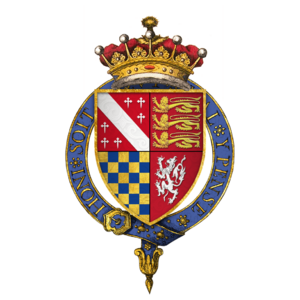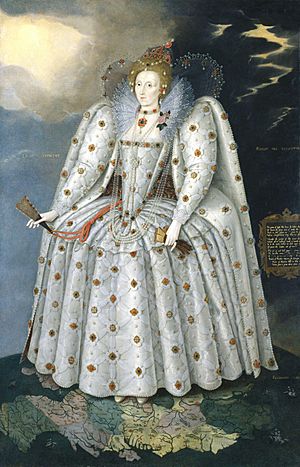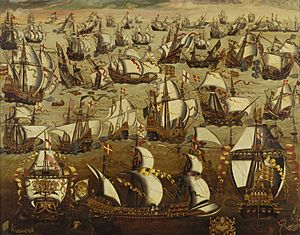Charles Howard, 1st Earl of Nottingham facts for kids
Quick facts for kids
Charles Howard
|
|
|---|---|
| Earl of Nottingham | |
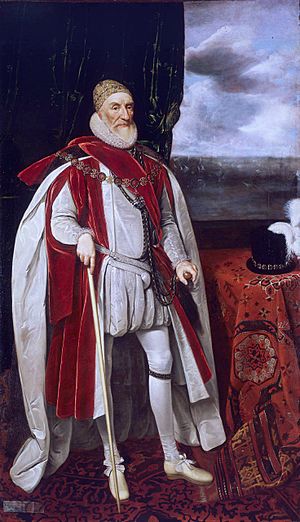
Charles Howard around 1620 (Daniel Mytens the Elder)
|
|
| Born | 1536 |
| Died | 14 December 1624 (aged 87–88) |
| Noble family | Howard-Effingham |
| Spouse(s) | Catherine Carey Margaret Stuart |
| Issue |
|
| Father | William Howard, 1st Baron Howard of Effingham |
| Mother | Margaret Gamage |
| Signature |  |
Charles Howard, 1st Earl of Nottingham, was a very important English leader. He was born in 1536 and died in 1624. He served under two queens and kings: Elizabeth I and James I.
Charles Howard was the Lord High Admiral. This meant he was in charge of England's navy. He is most famous for leading the English fleet against the powerful Spanish Armada in 1588. His leadership helped save England from being invaded by Spain.
Contents
Early Life and Family (1536–1558)
Charles Howard was born in 1536. He was a cousin of Queen Elizabeth I. His father was William Howard, 1st Baron Howard of Effingham. His mother was Margaret Gamage. He was also the grandson of Thomas Howard, 2nd Duke of Norfolk.
Charles was related to Anne Boleyn, who was Queen Elizabeth's mother. This family connection helped him get important jobs later on. He likely learned French and Latin at his uncle's home. He also learned writing, knightly skills, and some law. As a young man, he served his cousin Thomas, who later became the 4th Duke of Norfolk. He loved fishing and hunting throughout his life.
When he was young, Charles served at sea with his father. In 1552, he went to France to learn French better. But he soon returned to England because of some problems.
Starting His Career (1558–1585)
Charles Howard helped with peace talks between England and France in 1559. These talks led to the Treaty of Câteau-Cambrésis. He personally told Queen Elizabeth that the treaty was approved.
He was an Ambassador to France in 1559. In 1562, he became the keeper of the Queen's house at Oatlands. He often took part in jousting and tournaments. Even with his royal connections, it took time for him to gain personal benefits.
Howard was also a member of the House of Commons, which is part of England's Parliament. He represented the area of Surrey in 1563 and again in 1572.
In 1564, he joined Gray's Inn, a place for legal training. He earned a Master of Arts degree from Cambridge in 1571. He did this because it was common for men of his high social standing.
In 1569, he was a General of the Horse. He helped stop a Catholic rebellion in northern England. In 1570, he led a group of ships that escorted the Queen of Spain during her visit.
Howard became a knight in 1572. After his father died in 1573, he became Lord Howard of Effingham. From 1576 to 1603, he supported a theater group called Nottingham's Men, later known as the Admiral's Men.
In 1575, Howard was chosen for the Order of the Garter. This was a very important honor.
Lord High Admiral (1585–1619)
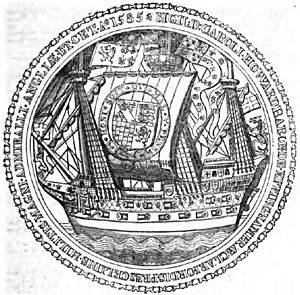
Charles Howard was made Lord High Admiral in 1585. This was a very important job. The French ambassador said that Queen Elizabeth chose him well. He believed Howard would do great things for the navy.
Mary, Queen of Scots (1587)
Howard was involved in discussions about Mary, Queen of Scots. He was one of the people chosen to look into her case. He spoke to Queen Elizabeth about the dangers she faced from plots against her. He urged Elizabeth to take action for her own safety. Elizabeth then decided to sign Mary's death warrant.
The Spanish Armada (1588)
In late 1587, Howard was ordered to prepare the English fleet for battle. His job was to attack and take control of any Spanish lands or ships if needed. He was given full power over the navy and army at sea.
Howard worked hard to get the fleet ready. He checked every ship himself. He wrote that the ships were in great shape and ready for long journeys. By May 1588, he was in Plymouth with a strong group of captains, soldiers, and sailors.
The Spanish Armada sailed from Lisbon but was forced back by bad weather. Howard believed the best way to fight them was to attack them in their own ports. He also warned Queen Elizabeth not to trust peace talks with Spain. He believed Spain was just using the time to gather its forces.
On July 19, Howard received news that the Armada was spotted off the coast of Cornwall.
On July 29, Howard wrote that the Spanish fleet was "wonderful great and strong." But he added, "we pluck their feathers by little and little." The English ships used their speed and cannons to damage the larger Spanish ships.
After the main battles, Howard chased the Armada north. He worried they might try to return. He wrote that the world had never seen such a strong fleet as the Spanish Armada. But the English had "marvellously plucked them."
After the victory, many English sailors became sick. Howard was very concerned. He wrote to Queen Elizabeth and other leaders about the terrible sickness spreading through the fleet. He said it was "a most pitiful sight" to see men dying in the streets. He used his own money to help them. He also asked for more funds to care for the sick and wounded sailors. He believed that if sailors were not cared for, it would be hard to find men to serve in the future.
Howard hired an Italian writer, Petruccio Ubaldini, to write about the Armada's defeat. He also asked a Flemish artist, Hendrick Cornelisz Vroom, to create tapestries showing the Armada battles. These tapestries were later bought by King James I and displayed in the House of Lords.
Cadiz Expedition (1596)
In 1596, England feared another Spanish invasion. Howard was again put in charge of defending England. He and the Earl of Essex led a joint attack on the Spanish base at Cadiz. This was a successful raid.
Third Spanish Armada
In 1597, another Spanish Armada tried to invade England. The Earl of Essex had left the English coast unprotected. But bad winds stopped the Spanish fleet. Howard took command and sent his fleet to find the Spanish ships. They captured a Spanish ship and learned about the Armada's retreat. Soon after, Queen Elizabeth rewarded Howard by making him the Earl of Nottingham.
Earl of Essex's Rebellion (1601)
When the Earl of Essex rebelled in 1601, Howard led the soldiers defending London. He defeated Essex's forces. Howard was also part of the group that examined Essex during his trial.
Death of Queen Elizabeth I (1603)
Howard's wife died, and this deeply affected Queen Elizabeth. She became very sad and felt her own death was near. Howard was with Elizabeth when she died. He asked her about who should be the next ruler. Elizabeth said it should be "our cousin of Scotland," meaning James VI. Elizabeth died on March 24.
Under King James I
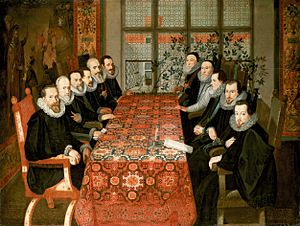
Nottingham served as Lord High Steward at the crowning of the new king, James I.
The king chose Howard to be part of the English group that made a peace treaty with Spain in 1604. He traveled to Spain to finalize the treaty. He exchanged gifts with the Spanish King Philip III. Howard received jewels and other valuable items.
Howard also helped with the plan to unite England and Scotland. He was involved in the trial for the Gunpowder Plot in 1605.
Later Life (1619–1624)
Charles Howard died in 1624 when he was 88 years old. His sons did not have children to continue his direct line. The title of Earl of Nottingham was later given to another relative.
Legacy
Many important books were dedicated to Charles Howard. William Bourne dedicated his 1578 book Inventions or Devices to him. Robert Norman dedicated his 1584 translations of Dutch sea guides to Howard. Richard Hakluyt's 1598 book The Principall Navigations was also dedicated to him.
Howard is sometimes linked to the character Marinell in Edmund Spenser's famous poem The Faerie Queene. He is also a character in the opera Roberto Devereux.
Today, there is a school named after him, the Howard of Effingham School, in Surrey, England. He was played by John Shrapnel in the movie Elizabeth: The Golden Age. His old estate in south Croydon is now the site of Whitgift School.
Family
Charles Howard was married twice. His first wife was Catherine Carey. They had five children:
- Frances Howard
- William Howard, 3rd Baron Howard of Effingham
- Charles Howard, 2nd Earl of Nottingham
- Margaret Howard
- Elizabeth Howard
His second wife was Margaret Stuart. She was much younger than him. They had two children:
- Charles Howard, 3rd Earl of Nottingham
- Anne Howard
See also
 In Spanish: Charles Howard para niños
In Spanish: Charles Howard para niños


